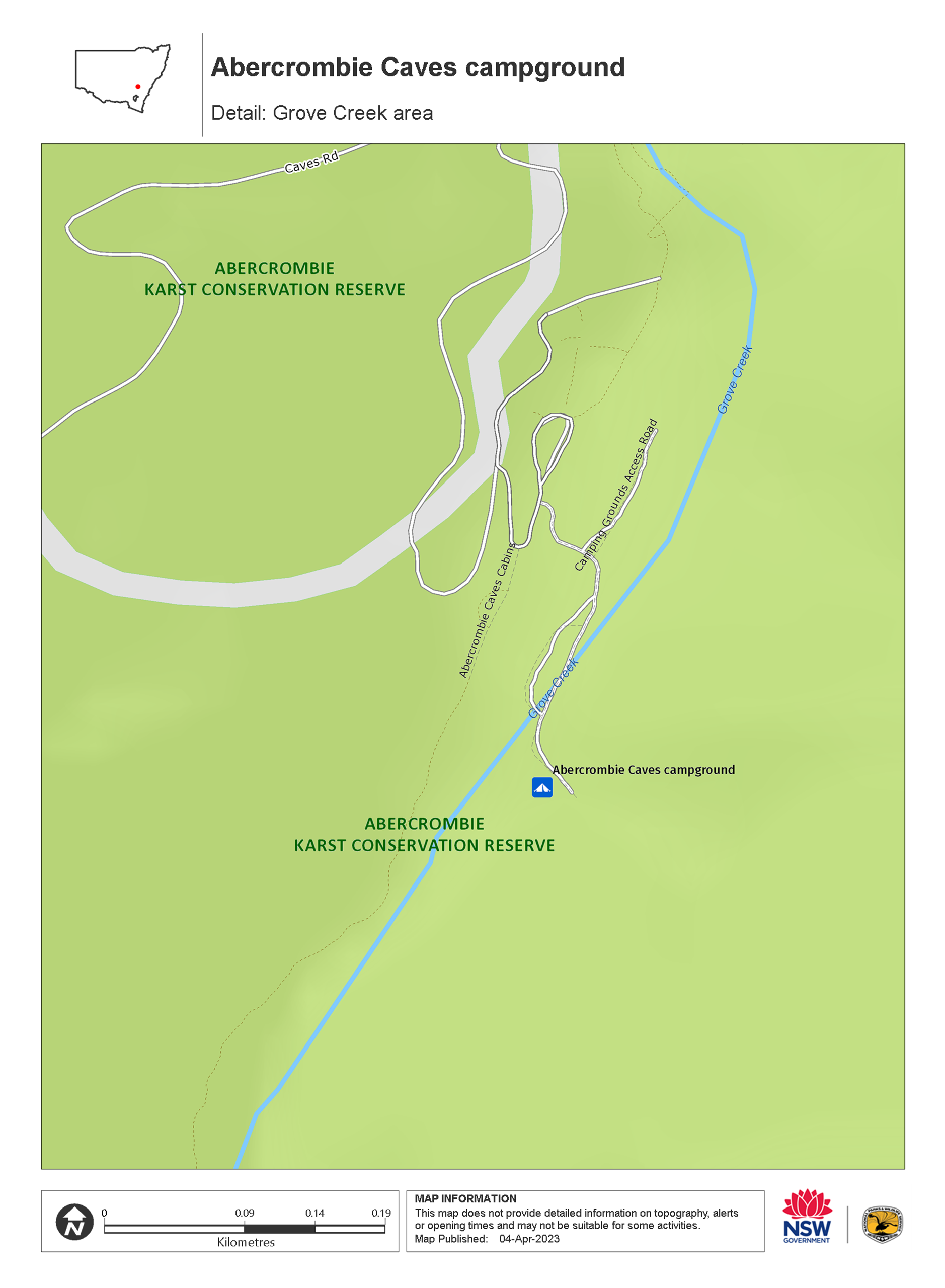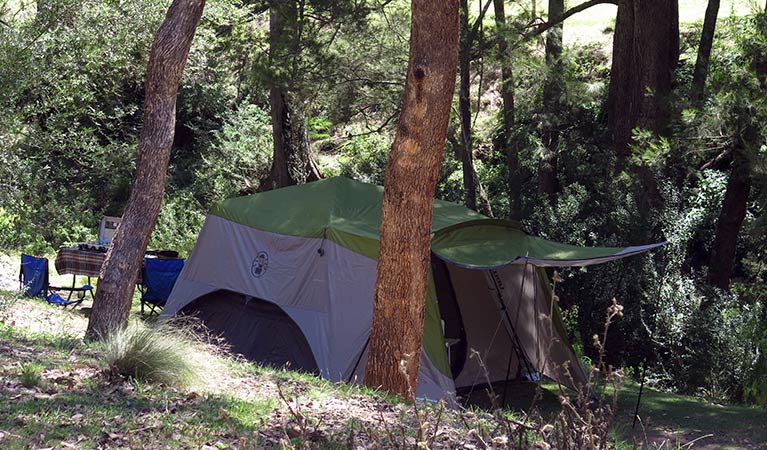Abercrombie Caves campground
Abercrombie Karst Conservation Reserve
Affected by closures, check current alerts
Overview
Abercrombie Caves campground is a great place to camp over the summer holidays. It's a picturesque camping area offering walks, swimming, picnicking, birdwatching and the luxury of a hot shower.
| Camping type | Tent, Camper trailer site, Caravan site, Camping beside my vehicle |
|---|---|
| Facilities | Toilets, showers, unpowered sites, unmarked sites, drinking water, barbecue facilities, picnic tables, electric power, amenities block, cafe/kiosk, public phone |
| What to bring | Firewood |
| Group bookings | Book up to 20 people or 5 sites online. For larger groups, make a group booking enquiry. |
| Please note |
|
Looking to get back to nature, but still want the luxury of a hot shower after a day of adventure? Abercrombie Caves campground is for you.
The first thing you’ll notice when you arrive here is the tranquil creek running through the camping area, with its clear waters and shady surrounds. Find yourself a grassy spot anywhere alongside the creek and pitch a tent or park your caravan.
Join one of the tours at Abercrombie Caves and be amazed at the incredible formations or check out the magnificent waterfall on Grove Creek Falls walking track.
Then head back to your campsite, throw a steak on the barbecue and enjoy the relaxing sounds of the nearby waters. As the sun sets, listen closely to nature’s orchestra, and keep your torch handy to spy possums in the trees or a wombat waddling past.
Map

Map legend

Local alerts
For the latest updates on fires, closures and other alerts in this area, see https://www.nationalparks.nsw.gov.au/camping-and-accommodation/campgrounds/abercrombie-caves-campground/local-alerts
Bookings
- National Parks Contact Centre
- 7am to 7pm daily
- 1300 072 757 (13000 PARKS) for the cost of a local call within Australia excluding mobiles
- parks.info@environment.nsw.gov.au
Operated by
- Abercrombie Caves office
- Thursday to Monday, 9am to 4.30pm. During NSW school holidays, 9am to 4.30pm daily. Closed Christmas Day.
- 02 6368 8603
- abercrombie.caves@environment.nsw.gov.au
- 272 Caves Road, Abercrombie River 2795
Park info
- in Abercrombie Karst Conservation Reserve in the Country NSW region
Abercrombie Karst Conservation Reserve and caves are open Thursday to Monday (closed Tuesday and Wednesday). The reserve and caves area open daily during NSW school holidays. Closed Christmas Day.
Visitor info
All the practical information you need to know about Abercrombie Caves campground.
Getting there and parking
Get driving directions
Abercrombie Karst Conservation Reserve is located in Central-West NSW, 1 hour south of Bathurst and 1.5 hours drive north of Goulburn. To reach the campground, enter the reserve and follow Caves Road to the visitor centre.
Road quality
- Sealed roads
Vehicle access
- 2WD vehicles
Weather restrictions
- All weather
Parking
Parking is available at Abercrombie Caves campground. Bus parking is available nearby.
Best times to visit
There are lots of great things waiting for you in Abercrombie Karst Conservation Reserve. Here are some of the highlights.
Autumn
Enjoy the cosy rooms and open fireplace at Arch Cottage and breathe in the crisp autumn air.
Spring
Pack a picnic and head off on the Grove Creek Falls walking track for a relaxing lunch with spectacular views of the waterfalls.
Summer
Step out of your tent and go for a refreshing swim in the pools of Grove Creek, then discover the natural wonders underground on a tour at Abercrombie Caves.
Winter
Explore the historic mining site at Mount Gray by day, then get cosy by the campfire at night.
Facilities
- Campsites are unmarked, unpowered and suitable for small caravans, camper trailers, campervans and tents.
- Rubbish bins are not available. Please take your rubbish with you when you leave.
Toilets
- Flush toilets
Showers
- Hot showers
- Cold showers
Types of sites
- Unpowered sites
- Unmarked sites
Drinking water
Barbecue facilities
Electric barbecues are coin operated and require $1 coins.
- Wood barbecues (bring your own firewood)
- Gas/electric barbecues (coin-operated)
- Fire rings (bring your own firewood)
Picnic tables
Electric power
Amenities
Cafe/kiosk
The kiosk sells small snacks and drinks. It's a good idea to pack a picnic if you'd like to enjoy lunch on your visit to Abercrombie Caves.
Public phone
Step-free access
The campground is step-free and mostly flat grass, with hard-packed ground and concrete pathways.
- Step-free outdoor pathways
Maps and downloads
Accessibility
Disability access level - medium
Abercrombie Caves campground is mostly flat and step-free, with hard-packed ground and concrete pathways. There are some areas where people with reduced mobility may need assistance:
- The toilets, showers and picnic tables are not wheelchair accessible
- You'll need to cross over flat grass to get to the parts of the campground that the paths don't reach
Permitted
You'll need a valid ticket or token to enter the caves. Cave entry is allowed during normal business hours; 9am to 4.30pm Thursday to Monday or daily during NSW school holidays.
Camp fires and solid fuel burners
Camping
Generators
Generators can be used in certain areas in the campground until 10pm. The campground has noise restrictions in place so visitors and wildlife can enjoy the park together.
Horses
Prohibited
- Amplified music is not permitted.
- Constructing stone rings to use as fire places is prohibited. Shared fire rings are available in the campground.
Drones
Flying a drone for recreational purposes is prohibited in this area. Drones may affect public enjoyment, safety and privacy, interfere with park operations, or pose a threat to wildlife. See the Drones in Parks policy.
This area may be a declared Drone Exclusion Zone, or may be subject to Civil Aviation Safety Authority (CASA) rules for flying near airports, aerodromes and helicopter landing sites. See CASA's Drone Flyer Rules.
Commercial filming and photography
Commercial filming or photography is prohibited without prior consent. You must apply for permission and contact the local office.
Fishing
Spear fishing is not permitted.
Gathering firewood
Firewood may not be collected from the park.
Pets
Pets and domestic animals (other than certified assistance animals) are not permitted. Find out which regional parks allow dog walking and see the pets in parks policy for more information.
Smoking
NSW national parks are no smoking areas.
Other important info
Learn more
Abercrombie Caves campground is in Abercrombie Karst Conservation Reserve. Here are just some of the reasons why this park is special:
Bushrangers

In 1830 armed settlers, mounted police, and an army regiment fought it out with the Ribbon Gang near the caves. Ralph Entwistle, a convict servant, led a rebellion of convicts at Bathurst. His gang became known as 'The Ribbon Gang' because many of its members were said to have worn white ribbons in their hats.
- Mount Gray walking track Mount Gray walking track, near Abercrombie Caves, is a bushwalk to the relics of a historic mining site. It continues on to the magnificent waterfalls and scenic views at Grove Creek Falls.
Caves of time

Abercrombie Caves and the surrounding area is part of the traditional country of the Burra Burra group, who are part of the larger Wiradjuri tribe. The Burra Burra group knew about the caves, although no Aboriginal artifacts have been found in Arch Cave itself. However, in 1977 a research team found stone tools and animal bones, inlcuding some from extinct animals, in a shelter north of the Great Arch.
Natural wonders

The natural wonders of Abercrombie Karst Conservation Reserve will inspire you. Rare plant species such as laurel-leaf grevilleas and Chalker's wattle brighten the area with vibrant shades of yellow and red. Lucky visitors may also catch a glimpse of wildlife such as vulnerable peregrine falcons and sugar gliders lurking through the trees. Wallabies are also known to call Abercrombie Karst Conservation Reserve home, so be sure to keep an eye out.
Underground wonders

As early as 1821, the Sydney Gazette reported that 'a cave of considerable dimensions has been recently discovered in the neighbourhood of Bathurst'. There's no wonder that almost 200 years later the caves attract visitors from far and wide. The famous Arch Cave is 221 metres long, 60 metres wide at both ends and 30 metres high in the middle. It's considered the largest cave of its type in the southern hemisphere. Join a cave tour and discover the incredible natural world underground.
- Grove Creek Falls walking track Grove Creek Falls is a must-see for visitors to the Abercrombie Caves area. This walking track offers magnificent waterfalls, bushwalking and picnicking.
Plants and animals protected in this park
Animals
-

Eastern bentwing-bat (Miniopterus schreibersii oceanensis)
Eastern bentwing-bats congregate in caves across the east and north-west coasts of Australia, in colonies of up to 150,000. These small Australian animals weigh around 13-17g and can reach speeds of up to 50km per hour. Eastern bentwing-bats use both sight and echolocation to catch small insects mid-air.
-

Swamp wallaby (Wallabia bicolor)
The swamp wallaby, also known as the black wallaby or black pademelon, lives in the dense understorey of rainforests, woodlands and dry sclerophyll forest along eastern Australia. This unique Australian macropod has a dark black-grey coat with a distinctive light-coloured cheek stripe.
-

Kookaburra (Dacelo novaeguineae)
Of the 2 species of kookaburra found in Australia, the laughing kookaburra is the best-known and the largest of the native kingfishers. With its distinctive riotous call, the laughing kookaburra is commonly heard in open woodlands and forests throughout NSW national parks, making these ideal spots for bird watching.
-

Superb lyrebird (Menura novaehollandiae)
With a complex mimicking call and an elaborate courtship dance to match, the superb lyrebird is one of the most spectacular Australian animals. A bird watching must-see, the superb lyrebird can be found in rainforests and wet woodlands across eastern NSW and Victoria.

